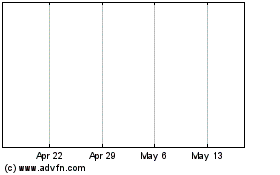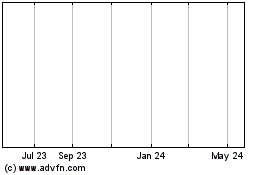Gripen Surpasses 100,000 Flight Hours. Volvo Aero's Engine Safest in the World
January 31 2008 - 9:12AM
Business Wire
Regulatory News: The Gripen aircraft surpassed the 100,000-hour
market during the week. It was during a flight over a snowy
Ostergotland landscape, with Saab's Chief Test Pilot Mats
Thorbiornsson and a Colonel in the South African Air Force at the
controls, that the historic milestone was surpassed. Notably in
this context is that during these 100,000 hours the Gripen was not
involved in an engine-related accident or serious incident. This
ought to be unique for all air forces worldwide. Ever since its
maiden flight, the Saab test team has carefully tracked each hour
flown. The same strict logging was carried out by the Swedish Air
Force, by Gripen's customers in Hungary, Czech Republic, pilot
training in the UK and in South Africa. As a result, it was known
that this week the 100,000th hour was near. On the morning of
January 28, the magic milestone was surpassed. There was no plan
for any big ceremony. In March, the first Gripen aircraft will be
placed in active service in South Africa and the flight test
program is in full swing. At Volvo Aero, it was concluded that the
first 100,000 hours was surpassed without a single engine-related
accident or incident. "I think this must be a hard record to beat
for a single-engine application," says Rune Hyrefeldt, head of
Military Program management at Volvo Aero. The engine in the
Gripen, the RM12, is based on the General Electric F404 that Volvo
Aero's and GE's engineers adapted for the Gripen's needs in the
1980s. Since then, Volvo Aero has successively worked to reduce
cost of ownership and increase safety: -- Among other features, the
company developed an FADEC (Full Authority Digital Electronic
Control) system that optimizes operations, provides the possibility
to reduce fuel consumption and is simultaneously used for
trouble-shooting. -- Volvo Aero has also designed a new intake
component for the RM12 that facilitates lower costs and increased
availability. (Previously, the engine required inspection every 50
flight hours, now this is carried out during regular service.) --
Volvo Aero has designed a new afterburner flameholder that
drastically reduces operating costs and increases availability. The
new flameholder does not have to be replaced as often as its
predecessor and it can be switched out faster and easier. "The sum
of the first 100,000 hours with the RM12 in the air is that the
engine meets all the requirements placed by FMV (Swedish Defense
Material Administration) and the Air Force by a wide margin, in
terms of operating costs, reliability and operational performance,"
says Rune Hyrefeldt. Work is under way at Volvo Aero on the last
RM12 engine to the Swedish Air Force, Thereafter, production,
assembly and testing will apply to engines destined for the South
African Air Force. This work is expected to be concluded in 2011.
January 31, 2008 Volvo Aero (NASDAQ:VOLV) (STO:VOLVA) (STO:VOLVB)
develops and manufactures components for aircraft and rocket
engines with a high technology content in cooperation with the
world's leading producers. Volvo Aero offers an extensive range of
services, including sales of spare parts for aircraft engines and
aircraft, sales and leasing of aircraft engines and aircraft, as
well as overhaul and repair of aircraft engines. Volvo Aero is part
of the Volvo Group, one of the world's leading manufacturers of
trucks, buses and construction equipment, drive systems for marine
and industrial applications, aerospace components and services. The
Group also provides complete solutions for financing and service.
Images can be found under News images at
http://www.volvo.com/volvoaero/global/en-gb/newsmedia/image_gallery/
This information was brought to you by Cision
http://newsroom.cision.com Regulatory News: The Gripen aircraft
surpassed the 100,000-hour market during the week. It was during a
flight over a snowy �sterg�tland landscape, with Saab�s Chief Test
Pilot Mats Thorbi�rnsson and a Colonel in the South African Air
Force at the controls, that the historic milestone was surpassed.
Notably in this context is that during these 100,000 hours the
Gripen was not involved in an engine-related accident or serious
incident. This ought to be unique for all air forces worldwide.
Ever since its maiden flight, the Saab test team has carefully
tracked each hour flown. The same strict logging was carried out by
the Swedish Air Force, by Gripen�s customers in Hungary, Czech
Republic, pilot training in the UK and in South Africa. As a
result, it was known that this week the 100,000th hour was near. On
the morning of January 28, the magic milestone was surpassed. There
was no plan for any big ceremony. In March, the first Gripen
aircraft will be placed in active service in South Africa and the
flight test program is in full swing. At Volvo Aero, it was
concluded that the first 100,000 hours was surpassed without a
single engine-related accident or incident. �I think this must be a
hard record to beat for a single-engine application,� says Rune
Hyrefeldt, head of Military Program management at Volvo Aero. The
engine in the Gripen, the RM12, is based on the General Electric
F404 that Volvo Aero�s and GE�s engineers adapted for the Gripen�s
needs in the 1980s. Since then, Volvo Aero has successively worked
to reduce cost of ownership and increase safety: Among other
features, the company developed an FADEC (Full Authority Digital
Electronic Control) system that optimizes operations, provides the
possibility to reduce fuel consumption and is simultaneously used
for trouble-shooting. Volvo Aero has also designed a new intake
component for the RM12 that facilitates lower costs and increased
availability. (Previously, the engine required inspection every 50
flight hours, now this is carried out during regular service.)
Volvo Aero has designed a new afterburner flameholder that
drastically reduces operating costs and increases availability. The
new flameholder does not have to be replaced as often as its
predecessor and it can be switched out faster and easier. �The sum
of the first 100,000 hours with the RM12 in the air is that the
engine meets all the requirements placed by FMV (Swedish Defense
Material Administration) and the Air Force by a wide margin, in
terms of operating costs, reliability and operational performance,�
says Rune Hyrefeldt. Work is under way at Volvo Aero on the last
RM12 engine to the Swedish Air Force, Thereafter, production,
assembly and testing will apply to engines destined for the South
African Air Force. This work is expected to be concluded in 2011.
January 31, 2008 Volvo Aero (NASDAQ:VOLV) (STO:VOLVA) (STO:VOLVB)
develops and manufactures components for aircraft and rocket
engines with a high technology content in cooperation with the
world�s leading producers. Volvo Aero offers an extensive range of
services, including sales of spare parts for aircraft engines and
aircraft, sales and leasing of aircraft engines and aircraft, as
well as overhaul and repair of aircraft engines. Volvo Aero is part
of the Volvo Group, one of the world�s leading manufacturers of
trucks, buses and construction equipment, drive systems for marine
and industrial applications, aerospace components and services. The
Group also provides complete solutions for financing and service.
Images can be found under News images at
http://www.volvo.com/volvoaero/global/en-gb/newsmedia/image_gallery/
This information was brought to you by Cision
http://newsroom.cision.com
AB Volvo (MM) (NASDAQ:VOLV)
Historical Stock Chart
From Apr 2024 to May 2024

AB Volvo (MM) (NASDAQ:VOLV)
Historical Stock Chart
From May 2023 to May 2024
